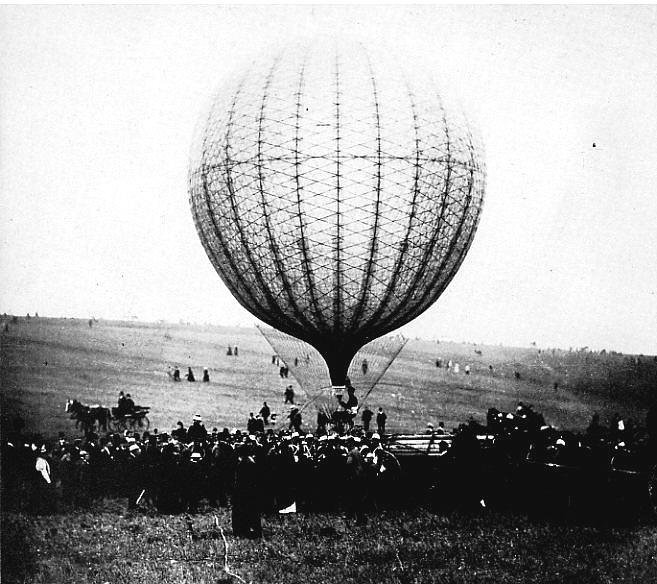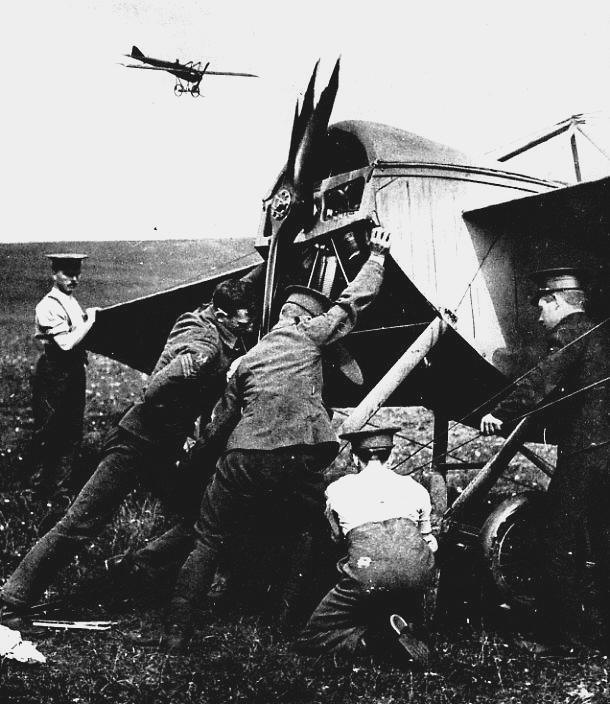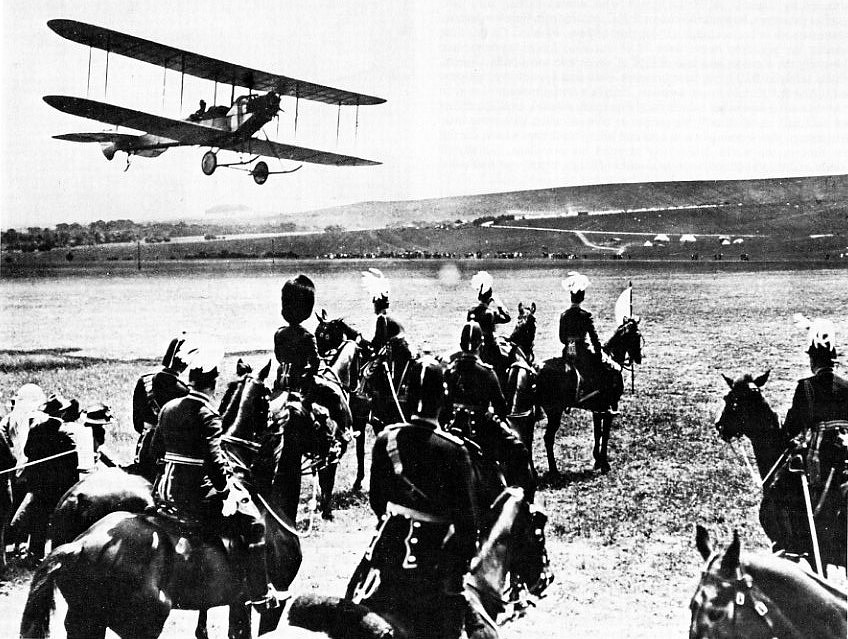Salisbury Plain
Note: This map is centred on Tilshead village which is pretty much in the centre of Salisbury Plain.
SALISBURY PLAIN: Major area for the use by the Army for exercises and manoeuvres
Note: This picture was scanned from John Fabbs excellent book Flying and Ballooning - from old photographs. His caption is : "The No.1 Balloon Section on military manoeuvres on Salisbury Plain, 1893."
This entire area is rich in aviation history. For example see my listings for AMESBURY, BOSCOMBE DOWN, LARKHILL, NETHERAVON, ROLLESTON CAMP and UPAVON.
Even today it is a common sight to see Army helicopters shuttling to and fro on a wide variety of exercises across this region.
This great picture was also scanned from John Fabbs book. The caption reads: "Members of the Army Flying Corps on Salisbury Plain during manoeuvres, August 1912. It is recorded that there were 'no fewer than 10 flyers in the air at one time soaring and swooping' I think this picture was taken at LARKHILL? And I very much doubt that "10 flyers" were in the air at one time as it seems to defeat the point of the exercise to determine the most suitable type for Army aviation use.
Please see my listing for LARK HILL where I think this picture was probably taken?
Yet another stunning picture, but this time scanned from the most excellent book, British Aviation - The Pioneer Years by Harald Penrose. First published in 1967. The caption is; "The military Wing 'fly-past' before the General Officer Commanding during manoeuvres on Salisbury Plain." I think the aircraft is a Royal Aircraft Factory B.E.2 type.
SALISBURY PLAIN: Early private flying school site…. contracted to mainly train military pilots?
Operated by: Bristol Flying School
Location: LARK HILL
Period of operation: 1911 to ?
NOTES: One proof that not only military pilots were trained to fly from SALISBURY PLAIN is that Collyns Pizey got his ‘ticket’ No:61 here in January 1911 although he was employed by the Bristol company and became a ‘demonstration pilot’ with them flying in Europe. He taught several German and Italian officers to fly and in September 1913 was chosen as Chief instructor to the Greek Navy
In 1912 Commander Oliver Schwann, after being heavily involved in the HMA.1 Mayfly project, (the first fateful British military airship), desired a future role in military fixed wing flying. This opportunity being denied, on February 5th he took his discharge on half-pay and enrolled with the Bristol Flying School. Typically, the exact location of this site like so many others, seems lost in the mists of time….unless you know differently of course. (See below and also LARK HILL)
SALISBURY PLAIN: Military flying area
User: Initially British military trials
Military user: WW1: RFC (Royal Flying Corps)
WW2: RAF (mainly AOP duties?)
Since 1945: Army
Location: Almost impossible to define exactly over nearly a century of activity but generally speaking it is a large area very roughly oblong in shape 16nm East to West and roughly 8nm at best from North to South. N & NE of Salisbury, W & NW of Andover, (the A303 roughly defining the southern limits). Warminster and Westbury to the west plus the A36 and A350 pretty much define the western limits too. The B3098 and further east the A342 contain thenorthern limits and in the east the A345 from Upavon to Amesbury closes the ‘box’.
Period of operation: 1910 to -
NOTES: When the War Office first offered use of a large area of Salisbury Plain to anybody seriously interested in the new-fangled flying business it would seem the area intended for aviation use was fairly near the LARK HILL barracks and the pubs in Amesbury were within striking distance too it is claimed!
It seems that Captain Bertram Dickson and (rank?) Lancelot Gibbs, (acting as Observation Scouts’ performed the first aerial trials in late September 1910 (Dickson flying a Bristol biplane, presumably Gibbs too?). It is claimed Captain Dickson performed the first aerial reconnaissance flight, in front of Allenby, Churchill, French and Haldane on the 21st.
These flights were undertaken whilst faced with considerable scepticism and lack of co-operation from Army officers and - at their own expense! Doing all this out of a sense of duty.
Remarkable men I trust you’ll agree. Despite poor weather and many other problems it would appear that the success they achieved convinced the ‘top brass’ that aviation did indeed deserve consideration. Lord Esher issued a report recommending that thirty to forty aeroplanes should be purchased and, on the 1st of April, (how often does this date crop up!), in 1911 an Air Battalion of the Royal Engineers was formed, the forerunner to which later became the Royal Flying Corps.
The type of flying activity which went on in this area seems to be unique in British aviation history especially for fixed wing types in WW1 and in many ways still goes on today albeit with helicopters in as much as, although in a heavily controlled military environment the pilots were/are expected to find ad-hoc suitable but often minimal landing sites. Much like the air ambulance pilots in recent years of course. It is hardly surprising to discover that many if not most of the air ambulance pilots come from the military helicopter sector.
Let’s face it, the military, (and not just the British), mostly prefer to base their aircraft on sites so large they resemble townships and therefore make ideal targets for an enemy.
As far as I can make out in WW1 the aerodromes of UPAVON, (Central Flying School which combined RFC and RNAS), and NETHERAVON (Army later RFC) were the fixed bases especially for elementary training plus serious maintenance and repair, but many piecemeal ‘temporary’ landing sites were used across the Plain to fit in with Army training excercises inmuch the same way the RFC fittted in with the ‘land’ Army demands in northern France where the real war was happening. In other words although ‘permanent’ aerodromes were established the RFC had to be trained in quickly setting up temporary aerodromes at short notice and their pilots trained in how to find and use these sites.
As a pilot I now have so much admiration for those highly experienced pilots who really could ‘think on their feet’ so to speak and operate in such an environment. Needless to say it was a highly flawed enterprise at best and a huge number of accidents occurred especially amongst the ‘rookie’ pilots whose short and highly regimented training regimes were hardly suited to what we today would regard as difficult ‘bush’ flying only to be attempted by very experienced pilots
The first ‘official’ record I discovered relating to Salisbury Plain is when Major J D B Futton, flying a Farman Biplane here was granted his pilots certificate, number 27 dated 15/11/10. It was over a month later until Lieut. R A Cammell was granted his Pilot Certificate dated 31/12/10 flying a Bristol Biplane on Salisbury Plain. It must be remembered though that the date the Certificate was issued in those days bore no relationship to the date the final flying test was performed. This system didn’t change until 1913
I have to report, (the circumstances behind this seems to me to be utterly fascinating), that a gentleman named Zee Yee Lee gained his Pilot Certificate No: 148 dated 17/10/11 on SALISBURY PLAIN. Can anybody furnish more history about this person?
This to me is very frustrating. It appears the War Office Military Aeroplane Competition was held on SALISBURY PLAIN, in August 1912. But where? It would seem to have been held at a site unconnected with LARK HILL or NETHERAVON? It is important to note that even in those days the performance of the airframe and engine were viewed separately in many respects. Exactly the same considerations apply today of course.
Aircraft or airframe entries to the competition included only British and French designs.The engines or ‘Motor’ came from Britain, France, Germany and Austria. Oddly though both the German and Austrian engines were both ‘Daimler’ types. The mix of pilots is very interesting in one singular respect. Apart from the expected British and French pilots a Peruvian pilot was also taking part! What was his history?
I think it worth quoting the table laid out by C C Turner in his book Old Flying Days and my legend is:
A = Austrian B = British F = French G = German P = Peruvian
You will notice that in three cases no pilot name appears against an entry and I can only assume (?) this indicates the aircraft didn’t compete? And why didn’t the nationality of Mr Parr get assigned?
BIPLANES
Aeroplane Motor Pilot
Avro (B) Green (B) Lieut. W Parke (B)
Bréguet (B) Salmson (F) Moineau (F)
Bristol (B) Daimler (G) Gordon England (B)
Bristol (B) Gnome (F) H Pixton (B)
Cody (B) Daimler (A) S F Cody (B) *
Coventry Ord. (B) Gnome (F)
Coventry Ord. (B) Chenu (F) T O M Sopwith (B)
Farman (F) Renault (F) P Verrier (F)
Flanders (B) A.B.C. (B) F P Raynham (B)
*Had Cody become a British citizen by August 1912?
MONOPLANES
Aerial Wheel (B) N.E.C. (B)
Blériot (F) Gnome (F)
Blériot (F) Gnome (F) Perreyon (F)
Bristol (B) Gnome (F) J Valentine (B)
Bristol (B) Gnome (F) H R Busteed (B)
Deperdussin (B) Anzani (F) Lieut. J C Porte (B)
Deperdussin (B) Gnome (F) M Prévost (F)
Handley Page (B) Gnome (F) E Petre (B)
Hanriot (F) Gnome (F) S V Sippe (B)
Hanriot (F) Gnome (F) Bielovucie (P)
Martin-Handasyde (B) Chenu (F) C Gordon Bell (B)
Mersey (B) Isaacson (B) R C Fenwick (B)
Pigot (B) Anzani (F) Parr (?)
Vickers (B) Viale (F) Macdonald (B)
Perhaps another surprise to be found in this listing is that the Deperdussin aircraft types submitted for these trials were considered to be British types? I have to say also that I’d never heard of some of these aircraft manufactures such as Aerial Wheel, Coventry Ord (which Iassume is Coventry Ordnance?), Flanders, Mersey and Pigot. The clear winner of the trials was S F Cody who had designed and hand built his aircraft in a shed on LAFFIN’S PLAIN near FARNBOROUGH. Perhaps we can now imagine his bitter disappointment, even chagrin, when he learnt the orders would be going mainly, (were other orders placed?), to the Bristol Aeroplane Company.
Just as an aside, being of the generation born just after WW2, a 'baby boomer', I find it fascinating that the uniforms, especially the headgear, worn by these military top brass, could ever have been considered as the height of style. They look like the kind of costume worn only by buffoons, which many of them were we now realise?
I came across a research study which claimed that, if given a modern I.Q. test, a large proportion of the senior Army Staff in WW1 would have been awarded 'Moron' status. And, reading the history, it seems hard to disagree.
The advances in the British Army seems to parallel, almost exactly, those made in aviation during the last century or so. Except that generally speaking, the Army have had, and certainly now have, a much more difficult job to perform.
Peter Adams
This comment was written on: 2017-08-08 12:41:26A wonderful website with so many things not to be found elsewhere online. I think I'm heading for a divorce spending all my time on here for weeks and weeks! Thanks for a great contribution. Peter.
Reply from Dick Flute:
Hi Peter, Many thanks indeed, I'm glad you find it of interest. But please don't spend too much time! Best regards, Dick
We'd love to hear from you, so please scroll down to leave a comment!
Leave a comment ...
Copyright (c) UK Airfield Guide


















